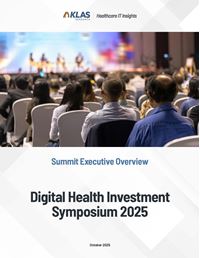

DHIS 2022
In September 2022, KLAS hosted the sixth annual Digital Health Investment Symposium (DHIS). Executives from healthcare provider organizations, HIT companies, investors, and innovators came together to collaborate on important developments in healthcare technology. Drawing on insights from a pre-summit survey as well as insights shared at the summit in small-group discussions, this paper highlights core challenges identified by summit participants and short-term and long-term solutions.
The Pre-Summit Survey
To gather contextual insights before the tabletop discussions, KLAS asked attendees to complete a pre-summit survey identifying (1) the top pain points in healthcare and how confident they feel addressing those challenges, (2) the impact of current staffing issues on organizations, and (3) their actions to mitigate that impact.

Key Challenges Identified by Respondents from Provider Organizations
Among respondents from provider organizations, the following are the top pain points identified in the pre-summit survey. Their confidence about tackling these challenges varies.
The patient experience: Nearly 30% of respondents from provider organizations reported the patient experience as a challenge they feel confident tackling; specifically, they feel confident in patient outreach, engagement, messaging, and creating a seamless experience for the patient. No one identified the patient experience as an area where challenges are going unaddressed.
Workforce management: Respondents’ confidence in their ability to address workforce management pain points varies. They feel confident addressing challenges with staffing and capacity management in the short term, including by using automation, but note the need for additional help developing long-term strategies for acquiring, training, and retaining talent.
The clinician experience: Some respondents feel confident addressing challenges with documentation and other inefficiencies that affect the clinician experience; others report unaddressed pain points, including documentation, the administrative burden, and EMR workflows and usability.
Siloed technology and data: Technology and data siloes are the most common problem that respondents from provider organizations feel they need more help addressing; none feel confident tackling this issue. Specifically, the responding providers mentioned a lack of true interoperability and said that poor integration and scalability of disparate point solutions exacerbate staff burnout and contribute to problems with training and retaining talent.
In the survey, some pain points were less frequently mentioned, though still noteworthy. As above, confidence tackling these pain points varies among respondents.
- Pain points some providers are confident tackling: Clinical care, revenue cycle management, and enterprise analytics across the business.
- Pain points some see as unaddressed challenges: Revenue cycle management, payer/provider interactions, new regulations, misalignment between patient care goals and business objectives, analytics on large data sets, and cost of care.
Nearly All Are Feeling the Pain of Staffing Shortages

Majority of Current Mitigation Strategies Are Unsustainable

Summit Questions and Discussion
The pre-summit survey questions were used to contextualize and provide a framework for the small-group discussions during the summit. At the summit, KLAS posed the following discussion questions to the groups (each composed of an even mix of attendee types):
- 1. What short-term mitigation strategies have been most successful for addressing staffing challenges?
- 2. In terms of the long-term needs of healthcare staffing and workforce management, what is or should be technology’s role in the retention of healthcare talent?
- 3. What is the next big step to ensure a stable healthcare workforce long term?
The following section highlights discussion themes and insights from these questions.
Small-Group Discussion Insights
1. What short-term mitigation strategies have been most successful for addressing staffing challenges?
- Attendees noted that higher compensation has plugged staffing gaps in the short term but is unsustainable in the long term.
- Some healthcare organizations have taken the innovative approach of creating internal float pools that allow the organizations to fully staff shifts across their enterprise while giving staff opportunities for variety and flexibility.
- Attendees reflected on the alignment of processes and workflow to keep people working at the top of their licensure as much as possible.
“We are seeing a push toward automation to collect bills digitally in order to reduce stress on call centers. The more you can automate processes, the more time you give back to staff by eliminating manual tasks.” —Summit attendee
2. In terms of the long-term needs of healthcare staffing and workforce management, what is or should be technology’s role in the retention of healthcare talent?
- Above all, attendees saw automation as an important long-term goal for healthcare in general and, specifically, to allow providers to work at their top of their licensure. However, many shared worries of new technology creating more problems. To address this, attendees stressed the importance of technology working holistically with workflows and of developing solutions with clinician input.
“Satisfaction may not surround technology problems. We can’t get nurses to use new workflows. There is a documentation burden, but the nurses don’t want to be told how to do their jobs. Technology isn’t the solution; reinventing the workflows is the solution. Then you can fit the technology to the new workflow. Documentation workflow needs to be highlighted, measured, and chipped away at.” —Summit attendee
“The voice of the clinician can get lost in the noise of big IT systems—particularly EMRs. Developers need to make things easier and listen to the clinicians who use the systems.” —Summit attendee
- Other ideas to extend the healthcare workforce included bringing virtual care into the mainstream and exploring the potential of physicians and nurses working from home.
3. What is the next big step to ensure a stable healthcare workforce long term?
- Attendees noted that administrative overhead is by far the largest pain point regarding the healthcare workforce. The current back-end financial processes create an extreme burden on staffing and administration. A more streamlined claims process and greater trust between providers and payers will be necessary for the long-term health of the healthcare workforce.
“There are many people in hospitals and payer organizations whose sole job is to call and fax each other about claim statuses. Some of those administrative tasks are being eliminated by automation, but that is taking time and trust.” —Summit attendee
- The burden of the technology stack was frequently cited as a major pain point that bars the way to a better long-term healthcare workforce. Even with all of the advantages and improvements in care that technology offers, the growing complexity of the technology stack has led to workforce misalignments and an additional burden on the system in terms of cost and FTE/hourly maintenance. Attendees stressed the importance of new and existing solutions that integrate into the technology stack.
“The ROI needs to make sense. A piece of technology may reduce FTEs, but the cost might not justify the savings. A lot of technology has great potential but is not scalable or cost-effective. Technologies need to be scalable and financially justifiable.” —Summit attendee
Conclusions
On the heels of the global pandemic, DHIS 2022 convened during a time of unprecedented staffing shortages, making it more important than ever to reflect on the current state of healthcare and how to solve tomorrow’s problems. While short-term solutions for staffing shortages exist, long-term sustainability remains a major challenge. Technology automation has a critical role to play but must integrate well into already-existing workflows to be effective; new technology cannot afford to create new problems for a workforce that is rapidly approaching burnout. (For more information on provider burnout and the EHR experience, see this recent report from KLAS’ Arch Collaborative.) Improved trust and partnership between payers and provider organizations are keys to reducing the administrative overhead that is currently threatening the long-term stability of the healthcare workforce. KLAS would like to thank the thought leaders who attended DHIS 2022 and shared their insights with each other and the rest of the industry.
Attendees
Sponsors:
- Korn Ferry
- L.E.K. Consulting
- Marwood Group
- McDermott Will & Emery
- TripleTree
Investors:
- Apax Partners
- Bain & Company
- Bank of America
- Berkshire Partners
- Brighton Park Capital
- Capital One Healthcare
- Charlesbank Capital Partners
- EQT Partners
- Flexpoint Ford
- Fulcrum Equity Partners
- Gauge Capital
- Graham Healthcare Capital
- Great Hill Partners
- Gryphon Investors
- GTCR
- Guggenheim Partners
- KKR
- Noro-Moseley Partners
- Sixth Street
- SSM Partners
- Thomas H. Lee Partners
- Thoma Bravo
- TPG Growth
- Vestar Capital Partners
- Warburg Pincus
- WCAS
- Zelis
Providers and Payers:
- Adventist Health
- Avant-garde Health
- Brigham and Women’s Hospital
- Caribou Memorial Hospital
- Centene Corporation
- Children’s Health (Texas)
- Cleveland Clinic
- CommonSpirit Health
- Doctors For Visual Freedom
- Elevance Health
- Highmark Health
- Humana
- Intermountain Healthcare
- Mass General Brigham
- Mayo Clinic
- Mercy
- Nebraska Medicine
- Optum Care
- Phoenix Children’s Hospital
- TNT Health Enterprises
- Providence
- Quality Life Services
- St. Luke’s Health
- Summit Health
- U.S. Department of Health and Human Services, Office of the National Coordinator for Health IT
- University of Utah Hospital
- University of Pittsburg Medical Center
- US Acute Care Solutions
- Vanderbilt University Medical Center
Vendors/Consulting Firms:
- ABOUT Healthcare
- AccessOne
- AGS Health
- American Medical Association
- Andor Health
- Arcadia
- Atlas Health
- AvaSure
- AWS
- BioIntelliSense
- Bright.md
- CareAllies
- Caregility
- CarePayment
- CipherHealth
- ClearBalance HealthCare
- Consensus Cloud Solutions
- DeliverHealth
- Epic
- Evergreen Healthcare Partners
- Experian Health
- EY
- FinThrive
- Flywire
- Gozio Health
- Health Recovery Solutions
- HealthPay24
- HealthTalk A.I.
- Health Value Leadership
- HFMA
- Infinx Healthcare
- Infosys
- Iodine Software
- Luma Health
- Lumeon
- Mach7 Technologies
- MatrixCare
- MD Revolution
- N1 Health
- NEMO Health
- NextGen Healthcare
- Notable
- Okadoc
- Olio Health
- Pivot Point Consulting
- QGenda
- Qventus Medical
- R1 RCM
- Revecore
- RevSpring
- Roche
- Snowflake
- symplr
- Teladoc Health
- Verisma
- VisiQuate
- Vyne Medical
- Waystar

Writer
Carlisa Cramer

Designer
Breanne Hunter

Project Manager
Andrew Wright
This material is copyrighted. Any organization gaining unauthorized access to this report will be liable to compensate KLAS for the full retail price. Please see the KLAS DATA USE POLICY for information regarding use of this report. © 2025 KLAS Research, LLC. All Rights Reserved. NOTE: Performance scores may change significantly when including newly interviewed provider organizations, especially when added to a smaller sample size like in emerging markets with a small number of live clients. The findings presented are not meant to be conclusive data for an entire client base.









